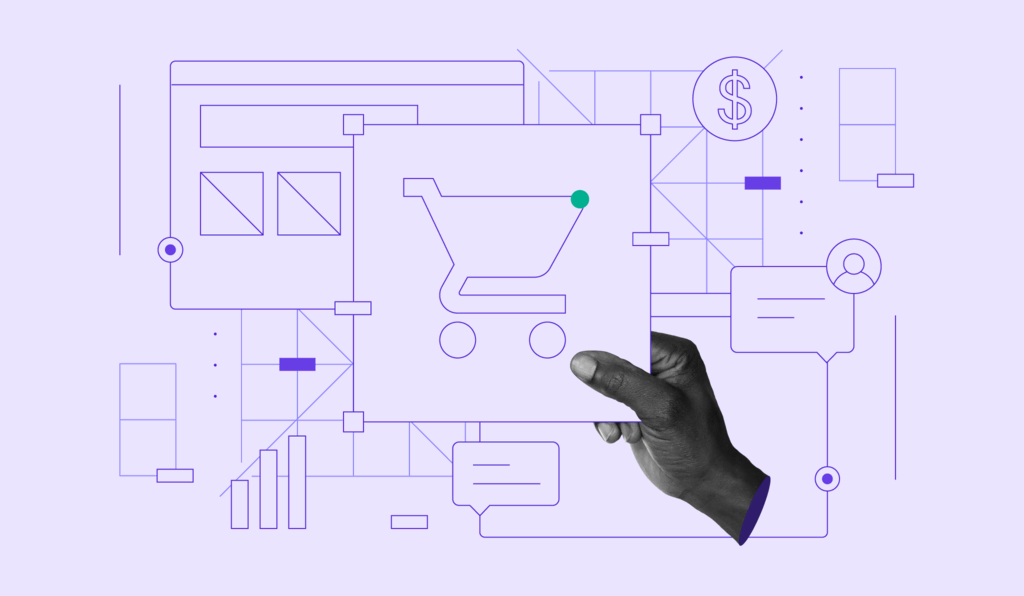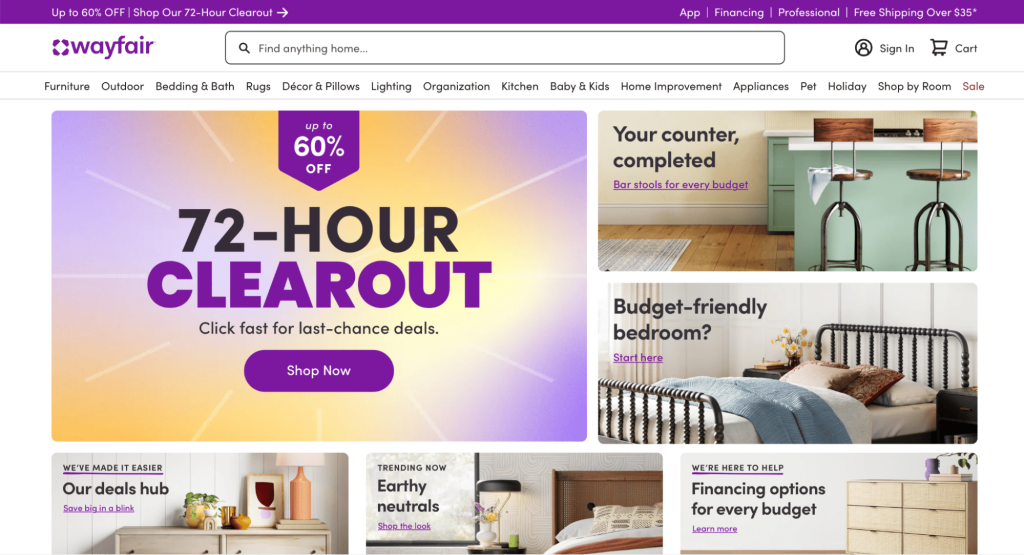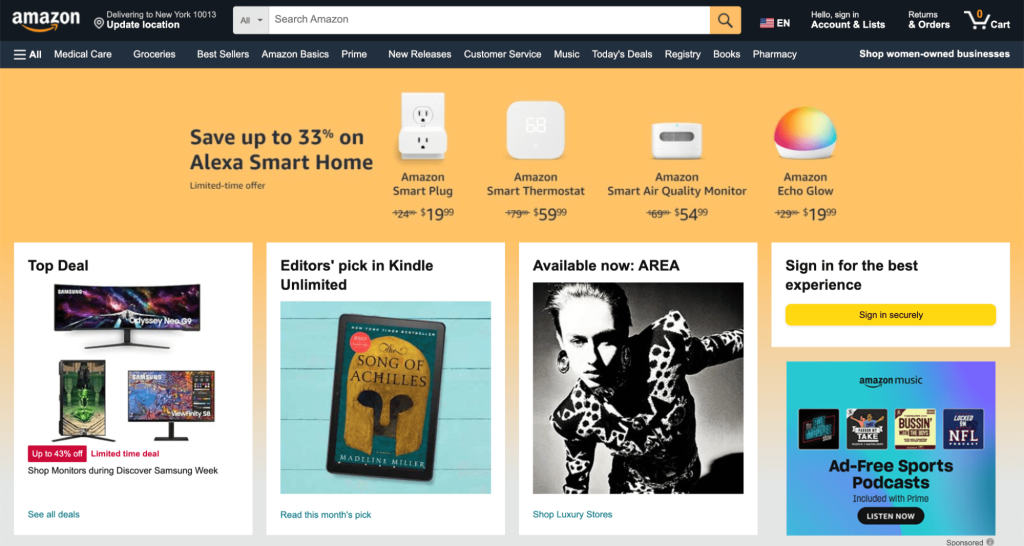What Is eCommerce? A Complete Guide to Get You Started

eCommerce, short for electronic commerce, refers to the act of buying and selling goods and services over the Internet.
Aside from allowing you to make money online, having an online store enables you to serve customers around the clock, solving the geographical limitations of brick-and-mortar stores.
This guide will explain what eCommerce is, offering insights into how it functions, what different types of eCommerce businesses there are, and the pros and cons of an online store compared to a brick-and-mortar store.
We’ll dissect key aspects of thriving eCommerce stores and highlight success stories from popular sites. Finally, we will show you how to launch your own store with Hostinger Website Builder.

How Does eCommerce Work
An online eCommerce store allows customers to browse products, add items to a digital shopping cart, and complete transactions through a mobile device or computer with an internet connection.
The physical products bought through these online transactions are then packaged and shipped to the buyers by the fulfillment department of the online retailer. Meanwhile, digital products can be sent instantly to the buyer for download.
What Are the Different Types of eCommerce Business Models
Each eCommerce type has different ways of facilitating and managing eCommerce sales. Let’s explore six of the most common online commerce models.
Business-to-Consumer (B2C)
Business-to-consumer is one of the most prevalent business models in online commerce. In B2C eCommerce, businesses sell products and services directly to consumers online.
The B2C model emphasizes a seamless customer experience, with online stores designed with intuitive navigation and simple purchasing flows to facilitate online sales.
B2C eCommerce is a popular choice for retail sales operations, as it’s convenient and relatively easy to set up and run. However, due to the popularity of B2C online businesses, expect to face fierce competition in saturated niches.
Example
Online marketplaces like Amazon are a classic example of the B2C model, where a wide range of products are sold directly to consumers online. Its success is largely due to its user-friendly interface and efficient delivery system, which enhance the customer experience.
Business-to-Business (B2B)
In contrast, business-to-business eCommerce focuses on transactions between businesses, such as suppliers selling to retailers.
Operating with a B2B business model often means you deal with bigger orders and repeat customers, which may require a more complex organizational structure. B2B online sales are usually more complicated than B2C ones and can take longer to negotiate.
Example
Alibaba operates primarily as a B2B platform, connecting manufacturers and wholesalers with retailers around the world. This platform facilitates bulk transactions and offers a variety of products, catering to the needs of different businesses.
Consumer-to-Business (C2B)
The C2B model flips the traditional selling online concept, allowing individuals to sell services or products to businesses.
A consumer-to-business model is often seen in freelance platforms and stock photo websites, where businesses seek specific services or products from individual providers.
This can lead to creative and affordable solutions for businesses, but the quality and the terms of the deals might vary.
Example
Upwork is a good example of the C2B model, where individuals offer their freelance services to businesses. This could range from graphic design to software development, providing businesses with a wide array of skills and services to choose from.
Consumer-to-Consumer (C2C)
Consumer-to-consumer eCommerce commonly connects consumers with each other on online marketplaces.
The C2C model has grown in popularity with the rise of social media platforms, empowering consumers to buy and sell goods and services without a middleman. C2C is great for finding unique items or deals, but it can come with risks related to payment security and product quality.
Example
eBay, a popular online marketplace, is a good example of the C2C model where individuals buy and sell items to each other. This platform is known for its auction-style listings and diverse range of products, from vintage items to used electronics.
Business-to-Government (B2G)
B2G, or business-to-government, involves businesses providing goods and services to government agencies.
This model often requires you to adhere to specific regulations and procurement processes. Generally, B2G commerce businesses have steady demand, but teams need to understand various rules and how to navigate through complex project bidding processes.
Example
Lockheed Martin, a global security and aerospace company, often engages in B2G transactions by providing advanced technology and services to various government agencies. Their contracts can include anything from military aircraft to cybersecurity solutions.
Government-to-Consumer (G2C)
G2C encompasses the services provided by government entities to individuals, such as paying taxes or renewing licenses online.
G2C eCommerce makes it easier for you to access government services online. While G2C services make many bureaucratic tasks more convenient, not everyone has easy access to the internet or feels comfortable sharing their personal data with the government.
Example
The IRS’s Free File program is an instance of G2C eCommerce, where the government offers free tax filing services to eligible individuals. This online service simplifies the tax filing process, making it more accessible to the public.
What Are the Advantages and Disadvantages of eCommerce
To decide whether creating an online store is right for you, let’s delve into the advantages and disadvantages of eCommerce.
The Advantages of eCommerce Businesses
Online stores offer advantages that a traditional physical store simply can’t match:
Round-the-Clock Shopping Experience
An online store breaks free from the constraints of time and location, offering customers the flexibility to shop whenever and from wherever they choose.
This 24/7 accessibility means your store is always open for business, catering to customers’ needs outside the traditional shopping hours and boosting your sales potential.
Expanding Your Reach Beyond Borders
eCommerce allows you to extend your business far beyond local boundaries, reaching customers across the globe.
This expansion not only widens your market but also diversifies your clientele, opening up opportunities in new regions and among various demographics.
Streamlined Operational Costs
Transitioning to an online model can significantly lower your business’s operational expenses.
Without the physical limitations of a brick-and-mortar storefront, you can save on rent, utilities, and in-person staff. Therefore, you can offer more competitive prices and improve your profit margins.
Facilitating Price Transparency and Comparisons
In an online marketplace, customers can effortlessly compare prices and products across different platforms, making informed decisions without the hassle of physically visiting multiple stores.
This transparency is beneficial for both consumers and businesses, as it encourages fair pricing and highlights the value of your products or services.
The Disadvantages of eCommerce Businesses
When considering starting your own eCommerce store, it’s important to be aware of potential challenges that could affect your business and your customers’ experience. Here’s what you need to know:
Delayed Customer Connection
Without the face-to-face interactions of a brick-and-mortar store, providing immediate help and tailored advice to customers becomes more challenging.
This can influence customer satisfaction, as shoppers may miss the personal touch and quick answers to their queries that they get in a physical store.
Delivery Wait Times
One challenge of running an online store is shipping. The excitement of a purchase can be dampened by the wait for the product to arrive, which can take anywhere from a few days to a few weeks, depending on where your customers are and what they’ve ordered.
While offering faster shipping options like same-day delivery can help, it’s not always possible for every product or location.
Additional Shipping Costs
Shipping fees can sometimes be a deal-breaker for buyers, especially for more affordable items or when shipping internationally. These added costs can make online shopping less appealing for some products, especially those that are available locally without the extra expense.
Customer Data Safety Challenges
In an online business, your customers trust you with their personal and financial details, making data security crucial. The risk of data breaches and online fraud is a significant concern in the eCommerce world, requiring continuous efforts to protect your store and maintain your customers’ trust.
More Complex Returns and Exchanges
Handling returns and exchanges can be more complicated online than in physical stores. The logistics involved in returning products, processing them, and managing refunds or exchanges can be cumbersome for both you and your customers, potentially impacting their shopping experience.
What Makes a Successful eCommerce Store
Creating a successful eCommerce store goes beyond just having an online presence. It involves a strategic balancing of product quality, branding, customer experience, and seamless on-page navigation.
Here’s how to build an eCommerce shop that not only attracts customers but also retains them.
Offer Exceptional Products
The foundation of a thriving eCommerce business is the products themselves. Interesting, high-quality products are what initially attract customers to your store.
Example – Walmart
Small businesses should take cues from retailers like Walmart, which is known for its vast and varied product selection that meets the needs of the brand’s diverse clientele.
This is why Walmart is able to maintain high standards for its eCommerce service:
- Comprehensive market research. Walmart invests heavily in understanding consumer trends and preferences, which allows them to stock products that are in high demand. Implementing a robust market research strategy helps businesses anticipate and meet their customers’ needs.
- Supplier relationships. Building strong relationships with suppliers is key to maintaining a diverse and high-quality product range. The brand’s extensive network of suppliers enables them to offer an array of products at various price points, catering to different customer segments.
- Quality control. Despite its vast inventory, Walmart does not compromise on quality. Implementing rigorous quality control ensures that customers trust the brand and keep coming back.
Walmart’s commitment to quality, despite its diverse selection of items, from daily essentials to the latest electronics, sets it apart from its competitors. This approach not only caters to a wide consumer base but also fosters trust and loyalty by consistently delivering value at competitive prices.
Craft a Compelling Brand Story
A compelling brand story can significantly enhance your eCommerce store’s appeal by creating emotional connections with customers.
Example – Wayfair
Wayfair has effectively differentiated itself in the crowded home goods market by crafting a compelling narrative around the joy and creativity of making a home. Their brand story is all about inspiring their customers to create spaces that reflect their personalities and lifestyles.
This is how Wayfair has created an effective brand narrative:
- Emotional engagement. Wayfair’s marketing strategies are designed to emotionally engage with their customers, making them feel that Wayfair understands their desire to create a comfortable and stylish home. Crafting marketing materials that resonate emotionally can significantly enhance brand loyalty.
- Content marketing. Wayfair uses blogs, social media, and other content marketing strategies to reinforce its brand story, providing valuable home decor tips and inspiration. Offering value beyond just your products can help build a community around your brand.
- Customer-centric approach. Every touchpoint with customers, from the website to customer service, echoes Wayfair’s brand story. Ensuring that your brand’s narrative is consistent and customer-focused across all channels can strengthen your brand identity.
Drawing inspiration from Wayfair, your eCommerce store should aim to tell a story that resonates with your audience. This narrative should weave through every aspect of your store, from product descriptions to marketing campaigns, creating a brand identity that customers feel connected to and are eager to support.
For more details on branding, check out our tutorial on how to build a brand from scratch.
Create a Unique Shopping Experience
To stand out in the competitive eCommerce landscape, tailor the shopping experience on your platform to reflect your brand’s uniqueness.
Example – Amazon
Amazon, for example, excels in creating a personalized shopping journey for its customers. Its eCommerce shopping experience feels unique to each shopper thanks to features such as personalized recommendations, one-click shopping, and Prime membership benefits that cater to individual preferences.
Here’s how Amazon does it:
- Data-driven personalization. Amazon’s recommendation algorithms are a cornerstone of their success, encouraging increased basket sizes and repeat visits. Leveraging customer data to personalize the shopping experience can significantly boost sales and customer satisfaction.
- Frictionless shopping. Amazon’s one-click shopping and easy checkout process minimize barriers to purchase, reducing cart abandonment. Streamlining the checkout process in your store can lead to higher conversion rates.
- Loyalty programs. Amazon Prime creates a sense of belonging and offers value through free shipping, exclusive deals, and unlimited access to streaming content. Developing a loyalty program that offers genuine value can enhance customer retention.
Incorporate elements such as personalized product suggestions, loyalty programs, and interactive product views to make the shopping experience memorable and engaging for your customers. These features make shopping convenient, quick, and tailored to each customer’s preferences and previous behavior.
Prioritize Customer Satisfaction
Repeat customers are the lifeline of your eCommerce business. That’s why customer satisfaction should be at the heart of your eCommerce operations and business processes.
Example – Zappos
Zappos, renowned for its exceptional customer service, sets a high standard for customer care in the eCommerce world. The brand’s 365-day return policy, free shipping, and dedicated customer service team illustrate their commitment to customer satisfaction above all else.
This is why Zappos is known as a top eCommerce brand for great customer service:
- Well-trained customer support team. Zappos empowers its customer service representatives to make decisions that prioritize customer happiness, leading to memorable customer experiences. Empowering your customer service team can enhance problem resolution and customer loyalty.
- Transparent policies. Zappos’ clear and customer-friendly policies, such as its return policy, build trust and confidence. Ensuring your policies are transparent and customer-oriented can mitigate hesitations and foster trust.
- Customer feedback loop. Zappos actively seeks and listens to customer feedback to improve its service continuously. Establishing mechanisms for receiving and acting on customer feedback can help you adapt and improve your products or services.
Ensure your store offers comprehensive support through various channels, easy and clear return policies, and proactive after-sales service to address any concerns or issues. Building a reputation for reliable and responsive customer service can significantly boost customer loyalty and word-of-mouth referrals.
Offering high-quality, personalized customer support is especially important if you are considering setting up a dropshipping business or using a third-party fulfillment service to manage incoming orders.
Ensure Seamless Online Navigation
The usability of your eCommerce site plays a crucial role in converting visitors into customers.
Example – Alibaba
Alibaba’s eCommerce website is renowned for its ease of use, intuitive design, and innovative features that facilitate a seamless shopping experience. From efficient search algorithms to mobile shopping, Alibaba ensures that customers can easily find and purchase what they need.
Some of Alibaba’s main strengths include the following:
- Advanced search functionality. Alibaba’s search engine efficiently handles vast amounts of products, making it easy for customers to find exactly what they’re looking for. Investing in advanced search functionality can significantly improve the user experience.
- Mobile-first design. With a significant portion of online shopping done via mobile devices, Alibaba’s mobile-optimized platforms ensure a consistent and seamless experience across devices. Prioritizing mobile commerce can also capture a wider audience.
- Technological innovation. Alibaba continually invests in new technologies to enhance the shopping experience, such as VR shopping and AI chatbots. Staying on top of technological advancements can keep your eCommerce platform ahead of the curve.
Your eCommerce site should offer intuitive navigation, quick load times, and a straightforward checkout process for the best user experience. Optimize your site for mobile commerce as well, ensuring that the shopping experience is consistent and efficient across all devices.
How to Launch Your Own eCommerce Business in 2024
Launching your own business is exciting, and with tools like Hostinger Website Builder, it’s more accessible than ever. Here’s a rundown on how you can get started with your online store using Hostinger eCommerce Website Builder:
Step 1: Define Your Niche
Before setting up your own eCommerce website, it’s crucial to identify your online business niche. This involves understanding your target market and the products or services you’ll offer.
Our in-depth tutorial on how to start an online business guides you through the process of identifying a profitable niche, understanding market demand, and setting clear business objectives.
After identifying a potential niche, conduct a competitive analysis to understand the landscape in which you’ll be operating. Look into competitors in the space to identify gaps you can fill or ways you can differentiate your products.
Tools like Google Trends and social media platforms can provide insights into consumer interests and emerging eCommerce trends within your chosen niche.
See our compiled list of the most amazing eCommerce websites in 2024 for more inspiration.
Step 2: Choose the Right eCommerce Platform
Selecting the right platform that aligns with your business needs helps you start and grow your business.
When comparing digital platforms, consider also your growth plans for the future. Scalability is key: ensure the platform can grow with your business, accommodating more products, higher traffic, and advanced functionalities like multi-currency support or international sales.
For a deeper comparison of eCommerce platforms to ensure you’re making the best choice, refer to our guide on the best eCommerce platforms.
Hostinger Website Builder is made for simplicity and efficiency, making it an excellent choice for entrepreneurs who are looking for a tool with a user-friendly design, direct-to-consumer eCommerce functionality, and a convenient mobile editor.
Step 3: Set Up Your Online Store
Customization is crucial in making your store stand out. Pay special attention to the user interface (UI) and user experience (UX) design of your store.
A well-designed website that follows web design best practices can significantly boost conversion rates by making it easy for customers to find what they’re looking for and complete their purchases.
Our guide on how to make an eCommerce website provides step-by-step instructions on selecting a template, customizing your store’s design, adding products, and configuring payment and shipping options.
With Hostinger Website Builder, setting up your online store is intuitive and straightforward. Simply choose from various customizable and mobile-friendly eCommerce website templates that cater to different industries and needs.
Step 4: Implement Effective Selling Strategies
Once your store is ready, it’s time to start driving traffic to your store and getting sales.
Begin by identifying your target audience and understanding their preferences and buying behavior. This knowledge will enable you to tailor your marketing efforts and product offerings to meet their needs effectively.
Utilize social media platforms and email marketing to connect with potential customers, offering valuable content that engages and informs them about what sets your products apart.
Our tutorial on how to sell online covers essential selling strategies, from optimizing product listings and implementing SEO best practices to leveraging eCommerce marketing.
Step 5: Monitor, Analyze, and Optimize
Launching your eCommerce site is just the beginning. Continuous monitoring and website optimization are key to sustaining growth and profitability. We recommend tools like Google Analytics to dive deep into your eCommerce data.
Analyze customer behavior, track sales trends, and use these insights to refine your products, marketing strategies, and overall customer experience.
Understanding the customer journey on your site can reveal friction points in the shopping process. Regularly updating your strategies based on data-driven insights can lead to continuous improvement in your store’s performance.
Focus on conversion rate optimization (CRO) strategies. This involves A/B testing different elements of your website, from product page layouts to call-to-action (CTA) buttons, to see what resonates best with your audience and drives sales.
Conclusion
Electronic commerce or eCommerce refers to the act of buying and selling products and services on online marketplaces and stores.
eCommerce helps entrepreneurs reach a global audience, operate with lower overhead costs, and provide remarkable convenience to customers compared to a physical store.
Success in this space requires an understanding of the various eCommerce models – such as B2C, B2B, C2B, C2C, B2G, and G2C – each catering to different market needs and operational complexities.
Drawing lessons from industry giants like Walmart, Wayfair, Amazon, Zappos, and Alibaba, business leaders can implement proven strategies for their own projects. For example, pay attention to the importance of comprehensive market research, quality control, emotional engagement, personalized shopping experiences, exceptional customer service, and seamless online navigation.
To embark on your eCommerce journey, remember to:
- Define your niche. Clearly understand your target market and what unique offerings you can bring to them.
- Select the right platform. Choose an eCommerce platform that aligns with your business needs and can scale with your growth.
- Craft a compelling brand story. Build an emotional connection with your customers through engaging narratives and value-driven content.
- Focus on customer satisfaction. Prioritize your customers’ needs and feedback to ensure their satisfaction and loyalty.
- Optimize for seamless navigation. Ensure your website offers an intuitive and frictionless shopping experience to maximize conversions.
Remember that the essence of a successful eCommerce business lies in creating an immersive brand experience that resonates with your audience. By implementing these strategies, you’re building an online destination where customers feel valued, understood, and excited to return to.
What Is eCommerce FAQ
Find answers to the most common questions about eCommerce sales below.
What Is the Most Common Type of eCommerce?
B2C is the most dominant eCommerce model. It enables direct transactions between businesses and consumers, offering a wide range of products and services online.
What Problem Does eCommerce Solve?
eCommerce addresses the limitations of physical commerce by providing a convenient, accessible, and efficient platform for buying and selling goods and services. It eliminates geographical barriers, reduces operational costs, and offers consumers a broader selection of products.
How to Start an eCommerce Business With No Money?
Starting an eCommerce business with minimal capital is feasible through models like dropshipping or affiliate marketing, which require less upfront investment. These models allow entrepreneurs to sell products without holding inventory, reducing the initial financial burden.
What Skills Are Necessary to Start an eCommerce Business?
Essential skills for starting and running a successful eCommerce business include digital marketing, SEO, web design, and customer service. Experience in data analysis and basic financial management can also contribute to the success of an online business.







Comments
October 05 2020
HI, I want to make an ecommerce website in wordpress with woodmart theme.Please tell me which hosting service will be best for this type of e-commerce store. Will your hosting service support wood Mart theme in wordpress woocommerce? Thanks
November 18 2020
Hey there Amir. Yes we would support the theme. For the plan recommendation, I'd recommend you to message support@hostinger.com with some more info about your project, such as expected visitors, etc.
January 12 2021
thanks for sharing this precious information with us, this is really helpful for me